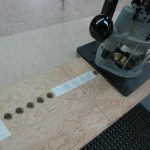We may receive a commission when you use our affiliate links. However, this does not impact our recommendations.

I drove to Indianapolis last weekend for dinner. Chris was demonstrating there at a Lie-Nielsen show, a friend who lives in California cashed in some frequent flier miles and flew in, and it’s always fun to see Angie and Alex and the rest of the show gang. And Chris has been raving about Brugge Brasserie, a restaurant that specializes in crepes, and has excellent French fries served with myriad dips. He was right to rave , I’d drive 100 miles again for those fries (and farther to see my friends, of course).
But before dinner, I stopped by the show , and couldn’t resist the pretty, shiny toys. I blew my monthly cheese budget on a low-angle block plane. When we got back to the office, Chris showed me how to check it for bed errors. I neither expected nor encountered any, but it doesn’t hurt to check (even at the store). Here’s how:
Pull the blade and check it for square. As you can see in the picture above, the bevel on this blade is ground just slightly out-of-square, though not enough to cause trouble for this “test.” I marked the high corner on the flat face so I can easily identify it when I put the blade back in the plane. (Were the blade way out, I’d need to regrind the bevel square before I could use it as a reference for bed errors , so were I in a store and that happened, I’d ask for a different blade.)
Now secure the blade in the plane and advance it into the mouth opening. Sight down the sole and use your thumb and index finger to square the blade in the mouth by eye , you’ll see a consistent black line all the way across the mouth when you’re there. 
If the square blade (or almost square blade) won’t line up, you may have a bed error. Ask for a different plane.
If all seems OK, retract the blade to working position, look at the blade in the mouth to make sure it still looks square, then take a shaving on a piece of scrap , you should be able to get a consistent shaving across the width of your test piece.
– Megan Fitzpatrick
Here are some supplies and tools we find essential in our everyday work around the shop. We may receive a commission from sales referred by our links; however, we have carefully selected these products for their usefulness and quality.









I’m glad to see this article posted as I have had the same thing happen to me with a contemporary plane.
Greg
Megan,
Looks to me like a Woodcraft mini square. Having taken returns on too many of them, I suggest you check the accuracy of your square.
Megan –
You are really progressing on your plane skills. Soon, your knuckles will be very hair and dragging on the ground like ours… Mwaaa haaaa haaa haaa!
Excellent article – I’m glad you were able to demonstrate this so I can check my planes.
Hi Megan,
If I understand what you and Chris mean by "bed error," it is when the geometric planes of the sole and the bed do not share a common edge.
To have no bed error, the geometric planes of the handplane’s sole and bed should be like opening a greeting card – two untwisted planes sharing a common theoretical edge. (A true dihedral angle.) In other words, the planes should not be tilted relative to each other.
To check for bed error, assuming the bed and the sole are at least reasonably flat, one only needs to set a flat blade with a straight cutting edge on the bed, then adjust it with the lateral adjuster or hammer so that it is parallel to the front edge of the mouth opening. (Assuming the mouth is truly perpendicular to the length of the plane – not something that is likely to be in error.) Then hold the plane up to the light and check if the blade projection is even all the way across the edge. If not, you’ve got bed error.
If the full width of the blade edge is consistently projected from the sole AND is parallel to a properly placed mouth, there is no bed error.
Whether the edge is ground perpendicular to the length of the blade is not a factor in this. One way to think of it is this: imagine making the adjustments then taking off a thin slice of blade width not parallel to its original side, such that the edge is now not perpendicular to the length. In such case, nothing changes with the rest of the geometry. This can be proven with a wooden or cardboard mock-up.
The exception would be in planes where the bedding of the blade is restricted laterally, but only because that precludes the lateral adjustment for the test. Alternatively, one can make the blade projection even and then see if the blade edge is parallel to the edge of the mouth.
Plain plane plane geometry. Hey, didn’t Shakespeare say something like that??
Rob